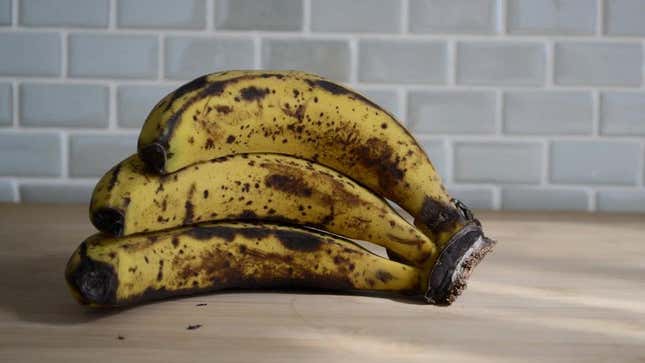
A Takeout reader recently reached out to see if we might be able to debunk a spooky story they’d been told about... bananas.
“A former colleague who took fancy evening cooking classes claimed that the 1st inch of a ‘nana should be cut off because that’s where tarantulas lay their eggs,” the reader wrote. “Was she dicking us around HS-style, or is it true?”
Now, I’ve recently encouraged everyone to get over their banana hangups. People freak out too much about bananas’ color, texture, bruising, and strings, and bananas of all kinds have (delicious) merit. But this seemed like a legitimate concern when picking out a bunch in the grocery store. So, is it true? The answer, quite unexpectedly, led me down a rabbit hole of banana-based myths and fears.
Are there spiders in your bananas?
While spiders can live on or around banana trees, the interior flesh of a banana itself is not a place they hang out, much less lay eggs in. The Burke Museum of Natural History and Culture explains it this way:
Flowers [of which the banana is the berry] change so fast that they would be poor places for eggs. Huntsman spiders guard their egg sacs in a leaf nest... Many other species found on banana plants do much the same. On rare occasions some spider may place an egg sac on the outside of an already-grown banana. Such an object would be hard for even the hungriest consumer to miss.
Indeed, in 2014 a woman complained to Tesco that she found a spider egg cocoon on a bunch of bananas purchased at the store. While her social media posts claimed the eggs belonged to a Brazilian wandering spider, “the most poisonous in the world,” that claim has since been debunked. The eggs, which were attached to the peel and not inside the banana, were likely those of a harmless spider species. Still gross, but not something you might unknowingly ingest.
Pretty much all viral stories about bananas are fake
Search internet debunking site Snopes.com for “bananas” and you’ll turn up a wealth of wild stuff. Here’s just a sample:
- Spider bursts out of overripe banana?
- Has Walmart recalled more than seven tons of parasite-ridden bananas?
- Are discolored bananas infected with HIV?
- Are bananas from South Africa or Costa Rica infecting consumers with flesh-eating disease?
I’ll save you a click: in all of these instances, the rumors surrounding bananas turn out to be patently false. In the case of the spider bursting forth from a ripe banana, we learn it’s the work of a talented CGI artist, and in the case of the Walmart recall, the rumor was disseminated by a false news source deliberately spreading misinformation. The “blood” in the “HIV bananas,” meanwhile, is merely the indication of a fungal disease within the plant, and while it’s not harmful for humans to eat, it might be just plain unappetizing.
Why are bananas always the victim of these damning reports? Their form might be partially to blame: anything with a peel or a husk might instill more fear in us, since the act of eating them requires us to “reveal” what has been hidden from view. But bananas, in particular, are also a fruit that is grown geographically far from Western consumers, in areas of the world considered remote or “exotic.” These banana urban legends might tap into consumers’ more xenophobic tendencies, conjuring up images of massive, venomous spiders and wild fungal growth.
Sometimes—most times, in fact!—a banana is just a banana, and any story you read to the contrary might not be the whole story.